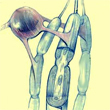Monday, 31 March 2014
Will You Be the Same Person in 10 Years As You are Now?
 Our thought processes are far from being as reliable and logical as we often think they are. In reality, our brains are constantly playing tricks on us, ranging from simple optical illusions to change blindness and other cognitive biases to the illusion that the self is a continuous entity that has the experiences that make up our lives.
Our thought processes are far from being as reliable and logical as we often think they are. In reality, our brains are constantly playing tricks on us, ranging from simple optical illusions to change blindness and other cognitive biases to the illusion that the self is a continuous entity that has the experiences that make up our lives.
Scientists are discovering more and more ways in which the brain fails to operate according to the simple common sense that we would expect. One notable example is the way that we perceive ourselves over time. In this regard, a study published in the January 2013 issue of the journal Science revealed a truly strange phenomenon that the authors call the “end of history illusion”—a reference to a concept originated by the German philosopher Hegel and advanced by American thinker Francis Fukuyama in a controversial 1992 book arguing that humanity had reached the end point in its sociocultural evolution. (more…)
Memory and the Brain | Comments Closed
Monday, 17 March 2014
Science Starting To Identify the Molecular Bases of the Sense of Touch
 When it comes to senses such as vision, scientists have known for some time which molecules are responsible for transduction—the conversion of physical stimuli into nerve impulses. Until recently, however, the molecular bases of the sene of touch remained ill-defined. But in an article first published online in the journal Nature in December 2012, Dr. Zhiqiang Yan and his research team from the University of California at San Francisco (UCSF) reported having found what they believed was the missing link in transduction for the sense of touch. (more…)
When it comes to senses such as vision, scientists have known for some time which molecules are responsible for transduction—the conversion of physical stimuli into nerve impulses. Until recently, however, the molecular bases of the sene of touch remained ill-defined. But in an article first published online in the journal Nature in December 2012, Dr. Zhiqiang Yan and his research team from the University of California at San Francisco (UCSF) reported having found what they believed was the missing link in transduction for the sense of touch. (more…)
The Senses | Comments Closed
Monday, 3 March 2014
The Various Speeds at Which We Perceive Time

Our perception of how fast time passes is amazingly subjective. When we are children, our summer vacations from school seem to stretch on forever. When we are grownups, we are often surprised to realize how long it has been since some major event occurred—Hurricane Katrina was over eight years ago, and the nuclear disaster at Chernobyl almost 28 years ago!
Thus we frequently underestimate or overestimate elapsed time. But what are the factors that push our estimates in one direction or the other? Are there some time scales that are affected and others that are not? Are there certain areas of the brain that are associated with the way we estimate time? (more…)
From Thought to Language | Comments Closed
Tuesday, 18 February 2014
Lasting Effects of Meditation
 A brain-imaging study published in the November 2012 issue of the journal Frontiers in Human Neuroscience seems to confirm past brain-imaging studies which found that meditation can help people pay better attention and manage stress more effectively. But the November 2012 study goes a bit further: it also shows that such measurable positive effects of meditation seem to continue even when the individual in question is not meditating. (more…)
A brain-imaging study published in the November 2012 issue of the journal Frontiers in Human Neuroscience seems to confirm past brain-imaging studies which found that meditation can help people pay better attention and manage stress more effectively. But the November 2012 study goes a bit further: it also shows that such measurable positive effects of meditation seem to continue even when the individual in question is not meditating. (more…)
The Emergence of Consciousness | Comments Closed
Monday, 3 February 2014
Glial Cells Too Are Sensitive to the Environment
 For a long time, the brain’s glial cells were assumed to be mere “filler” between the neurons. For a while after that, the glial cells were assumed to serve primarily nutritive functions. But now, year after year, research findings are showing glial cells to be more and more complex. For example, recent studies have shown their role in brain plasticity and how social isolation can disrupt it.
For a long time, the brain’s glial cells were assumed to be mere “filler” between the neurons. For a while after that, the glial cells were assumed to serve primarily nutritive functions. But now, year after year, research findings are showing glial cells to be more and more complex. For example, recent studies have shown their role in brain plasticity and how social isolation can disrupt it.
More and more studies indicate that people who experience severe neglect and social isolation as children display cognitive and social impairments as adults. To examine this phenomenon, two research teams recreated these unfavourable conditions for baby mice by placing them in isolation for several weeks. (more…)
From the Simple to the Complex | Comments Closed







